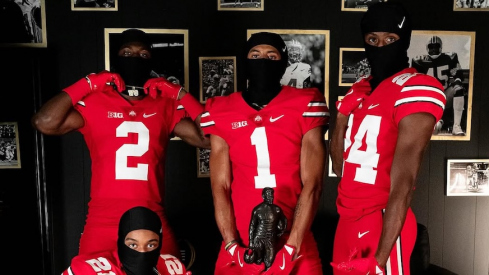In the second part of our interview with Ohio State Athletic Director Gene Smith, we catch up on the various playoff proposals floating around. You can read the first part, in which we discuss the turmoil of the previous 18 months, here.
December football has never been played in Ohio Stadium, but with the certainty of a four-team playoff on the horizon, Ohio State athletics director Gene Smith wants to bring his idea of a Winter Classic to a Midwestern campus near you. Smith, a firm believer in the Bowl Championship Series, has altered his views toward a playoff because, in his words, “it’s inevitable.”
But with new discussions about college football’s postseason come questions about the format and venues. Appropriately, as the Civil War Trust celebrates the on-going 150th anniversary of the War of Northern Aggression, the North and South fight again – this time in the form of the Big Ten and SEC – and instead of battles being waged in grassy fields, the two sides are airing grievances in teleconferences and board rooms. Instead of lobbing Civil War-era minié-balls, we have an array of presidents, commissioners and athletic directors, launching verbal salvos. University of Florida president Bernie Machen is running point for the SEC.
Machen said the SEC “won't compromise” on the issue of conference champions earning an automatic bid into the playoffs, saying, “I think the public wants the top four. I think almost everybody wants the top four.
“The group that's got to get real, the Big Ten's got to realize that the world is going in a different direction.”
Like Big Ten commissioner Jim Delany, Smith has taken Machen and other SEC compatriots’ talk in stride.
“It doesn’t bother me at all,” Smith said, shrugging his shoulders. “(The SEC) has been good the past five years. But they haven’t always been that good. Keep in mind (the Big Ten) dominated for a long time. Things are cyclical. That’s college athletics. There will be a time when someone else dominates. The Big Eight, with Oklahoma and Nebraska, dominated for a long time. You get used to it. That’s competition.”
Despite the recent domination of the SEC, which has fielded six consecutive national champions, the Big Ten, Smith included, would keep the status-quo if it were at all possible. Keep in mind, Ohio State’s national title a decade ago is the only piece of Waterford crystal a Big Ten team has returned to the Heartland since the inception of the BCS in 1998.
Some conferences – the SEC among them – want the best four teams to fill out a playoff, while others – including the Big Ten – want consideration for conference champions. Campus sites are favored by others, but there is also a large group who wants neutral sites at the current BCS games. Change brings along even more change.
“I’d like to see some type of consideration for the conference champions, maybe not for all four slots, but for two or three,” Smith said. “Say you’re ranked in the Top 6 and you’re a conference champion, you’re probably going to be ranked up there. But if you get through the Big Ten and SEC and win the conference championship, come on. I think you have to have some consideration for them. But I think there are a lot of moving parts there and that will make it hard.”
The Big Ten was in favor of on-campus playoff games when the postseason discussions began in the spring. That viewpoint, however, changed shortly thereafter. Instead, the Big Ten hopped aboard the neutral site bandwagon, with its infatuation with the Rose Bowl being the catalyst. Smith, though, believes multiple games away from Columbus – or any school’s home city – will put undo strain on fan bases.
“Fans are going to spend their money on holidays, then they’re spending money on the semifinals and if we’re fortunate enough to win, they have to spend money on the championship game in a shorter window of time,” Smith told Eleven Warriors last week. “The semis could be in Arizona and the championship could be in Atlanta. Combine that with the regular season, Big Ten Championship Game in Indianapolis and holiday money – I worry about that. If it were on campus sites, you wouldn’t have to spend as much. I think the fans that want to see (a playoff) don’t fully understand the burden it will put on themselves.”
The lack of a playoff also puts stress on fans and harms their health in more ways than one. Whether it’s high blood pressure because of an antiquated system or one fan tea bagging another only to be charged with sexual battery, the BCS can be hazardous to an entire nation’s health.
The “if you build it, they will come” phrase is apt for Buckeye Nation, an almost cult-like group that will travel from sea to shining sea to take in the atmosphere, pageantry and tradition of Ohio State football – especially when they’re contending for a national championship. The pilgrimage for Buckeye fans is akin to a religious journey, Ohio Stadium representing Mecca.
Asking them to do so in consecutive weeks might be expecting too much, however, even for the most devout followers. It’s similar to what Ohio State experienced in March and April, when the basketball team ventured from Indianapolis to Pittsburgh and Boston en route to New Orleans and the Final Four. During the dream four-week stretch, Ohio State exhausted its ticket allotment, but in much smaller numbers than would be available in 70,000-80,000-seat football stadiums.
“The semis could be in Arizona and the championship could be in Atlanta. Combine that with the regular season, Big Ten Championship Game in Indianapolis and holiday money – I worry about that."
-- Gene Smith
Smith’s career as an AD stretches back to 1990 and includes all 14 seasons of the BCS. He’s been at the lower rungs – Eastern Michigan – where a national championship is all but unachievable, middle-tier programs – Iowa State and Arizona State – that must do yeoman’s work to gain traction and respectability and a particular football factory that resides on the banks of the Olentangy – Ohio State.
The competiveness and levels of success may have varied at each stop, but one thing in each city and on each campus remained the same: fan support. Whether it’s Ypsilanti, Mich., or Columbus, Ohio, college football is woven into the fabric of the towns where the games are played.
For Smith, who’s under contract through 2016, the future is more like a dilapidated old farm house, not Taliesin. College football remains a vibrant enterprise, second only to the barbaric NFL, but the dramatic changes over time are harming the qualities that make the game great, according to Smith.
“It’s just simple marketing,” he said. “It’s the three Ps – price, place and product. All those you have to be sensitive to locally. We’re so focused on the back end – the bowls, the BCS and all of that – we forget the greatness of our sport is what happens locally – what goes on in Columbus, what goes on in Boise. Think about that – Boise. That is unreal what’s gone on there.
“I’ve already seen people saying we should reduce the regular season by one game so we can build a bigger postseason. That means you’re taking a piece of the local market where all that excitement exists. Once you’re out of the championship hunt, what’s going to happen to those local schools. Once they have that one loss the attendance starts to go down. Fans will say, ‘We’re out of it, I’ll just watch the game Saturday on TV.’ And then all that excitement deteriorates. To me, the reason college football is so successful is not from what happens in the postseason, it’s what happens in the regular season in the locales where these teams exist – what happens in Ann Arbor and what happens in Bloomington when we go there.”
In 2011, the Big Ten achieved a league-record 10 bowl berths that earned the conference schools $47 million in payouts. Each school netted around $2 million apiece after expenses were calculated. More than $28 million came from BCS bowls – Wisconsin in the Rose and Michigan in the Sugar. While the cash flow to the Big Ten universities every bowl season makes things easy for holiday shopping, the figures from a possible playoff dwarf what the conference pulls in now. Estimates have the TV rights alone for a playoff eclipsing the $1 billion mark. The current BCS TV contract is worth $125 million annually.
“I think the conferences will be bigger and they’ll shorten the regular season to 10 or 11 games to accommodate a bigger playoff. Now that is way down the road. I’ll be retired and up in the stands drinking beer.”
-- Gene Smith
“The regular season is fine,” Smith said. “The BCS created the strongest regular season. It has never been this strong. Everyone is looking for a definitive national champion, and it’s just not going to happen. There are going to be years where there is clearly one team that is the best. There will also be debates about whether the No. 5 or 6-ranked teams should be in. I understand what they are trying to achieve, but in my view, I think it will be very difficult to have a true national champion.”
That may be true in the beginning. But over time, formats are likely to change – the last half century of college football being a prime example. The best example, though, is the NCAA’s crown jewel – the men’s basketball tournament. What stands today as a 68-team, three-week journey filled with excitement started out as an eight-team also-ran event. College football’s postseason could be an unrecognizable 16 or 24-team affair in 20 years.
“No question, years from now,” Smith said with emphasis, “I think the conferences will be bigger and they’ll shorten the regular season to 10 or 11 games to accommodate a bigger playoff. Now that is way down the road.
“I’ll be retired and up in the stands drinking beer.”



